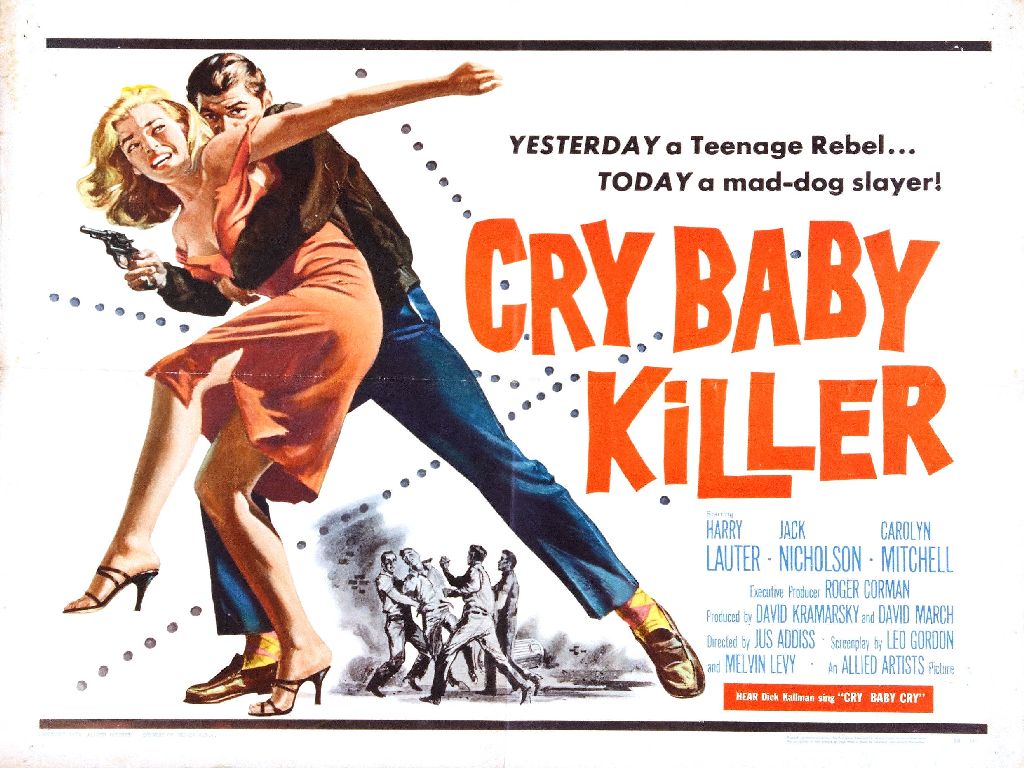In the film, Jack stars as teenager Jimmy Wallace, who, when we first encounter him, is in the process of getting the crap pounded out of him by a gang led by the suit-and-tie-clad Manny Cole (Brett Halsey). Later that evening, Jimmy enters the Klix Drive-In eatery, in which Manny presides like some kind of smarmy, thuggish demigod, determined to take back his girl, Carole (Carolyn Mitchell, whose only other film appears to be that same year’s “Dragstrip Riot”), from the older punk. A fight develops outside, during which Jimmy grabs a gun from one of Manny’s accomplices and shoots two of the toughs in the heat of battle. Thinking that he has slain the two youths (as it develops, he hasn’t; just wounded them in their intestines), Jimmy holes up in a shack next to the drive-in, holding a young mother and her baby, as well as an older black man, as hostages. And before long, a siege situation develops, as cops, spectators, relatives and a news crew gather, and Jimmy is soon being referred to as “the boy with the gun.”
Of course, the question uppermost in the viewer’s mind will probably be “Why doesn’t Jimmy just give himself up right away?,” but I suppose that if that were the way things logically transpired, this hour-long movie would barely have cracked the 10-minute mark. Rather, “The Cry Baby Killer” (an odd title, actually, given that Jimmy does not shed tears once and, as has been mentioned, is not actually a killer) treats the viewer to around 50 minutes’ worth of the head cop, Lt. Porter (Harry Lauter), questioning everyone at the scene, Jimmy’s parents and Carole begging the mixed-up nut via bullhorn to come out, and, most annoyingly, a newsman from KQQQ (!) repeating every incident that we have already witnessed for the benefit of the television viewers at home. Fortunately, we also get to see what is transpiring inside that shack, and thus are privy to Nicholson’s first on-screen rants, as he screams at the young mother to make her hungry baby stop crying. For all its brevity, the picture nonetheless seems to drag in parts, and indeed feels padded with needless scenes (the tentative romancing between cop Gannon and waitress Julie, for example). Curiously, the circus atmosphere that eventually develops at the siege site, with vendors selling hot dogs and Red Hots to the gawking crowd, is almost reminiscent of the situation that develops at the cave-in locale in Billy Wilder’s wonderful offering of 1951, “Ace in the Hole”; of course, “The Cry Baby Killer” should not even be mentioned in the same breath as that classic film. Besides Nicholson, only a few faces here will be at all familiar to most viewers: Ed Nelson as that TV reporter (Nelson also appeared in Corman’s popular schlock classics “Attack of the Crab Monsters,” “Teenage Cave Man” and “A Bucket of Blood,” but will probably be most recognizable to baby boomers by dint of his work on TV’s “Peyton Place”) and Herb Vigran as a shyster lawyer (Herb appeared as crooks no less than six times on TV’s “The Adventures of Superman”!). Oh…Corman is in there, too; a cameo as a TV technician whose only line is “Sounds OK!” And speaking of Roger, perhaps it would have been better for all concerned if he had indeed directed this film, as the work turned in here by Justus Addiss–who seems to have directed almost exclusively for ’50s and ’60s television–is pedestrian, at best. “The Cry Baby Killer,” to its credit, does feature a title tune that will likely work as an “earworm” in your head for many days. Composed and sung by actor and sometimes music writer Dick Kallman, this bizarre, repetitive number almost sounds as if it were being chanted by a beatnik, perhaps in a coffeehouse similar to the Yellow Door Cafe in “A Bucket of Blood.” This memorable tune, and the fact that this was indeed Nicholson’s first go before the cameras, are probably the two best reasons (possibly the only reasons!) for seeking out this otherwise forgettable film. At worst, it will inspire viewers to check out one of Jack’s later, better performances…such as masochistic dental patient Wilbur Force in the Corman-directed “Little Shop of Horrors,” for example. Now THERE’S a performance for the ages!

